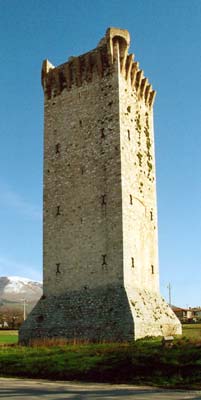|
To the east of the
Via Flaminia, the ancient Roman road, about halfway between Foligno
and Trevi, rises this interesting monument, arresting the attention of
the traveller, and keeping alive for us and for others a legend of
fearful events, of horrendous assaults and murders committed nearby.
We find many
interesting memories of the tower in our own archives, the Archivio
delle Tre Chiavi. On September 28, 1392 a certain Angelo del Medico
proposed to the City Council of Trevi that in order to defend against
malefactors who lurked in the environs day and night, committing all
sorts of crimes, a huge fosse or ditch be dug on the lower slopes of
the mountain of Matigge with a well-constructed tower, and that three
good men vested with full legal powers — tres bonos et legales
homines — be put in charge of the work. And in fact on
December 29th of that year Manente di Petruccio, Ser Angelo del Medico
and Ser Andrea di Ser Nuccino were duly appointed.
They did not,
however, set to work right away, and the Council had to insist that
they be requested to do so. To facilitate the work Del Medico was
given the right, on November 1, 1393, to exact a sort of forced loan
from the inhabitants of Matigge (imponere prestantiam) to be
paid back to them by discounts on their regular taxes in the future (in
successivis dativis).
So the required
equipment and material were gathered together, but by the end of 1394
the work had not yet started; and on December 18th of that year the
Council pressed the Commission once again to think seriously about
building the Tower.
Finally, on
January 10, 1395 the contract was drawn up with the mason Gregorio
da Cerreto, who had also built the Tower in neighboring Fabbri,
requiring of him various terms and conditions, and imposing a fine of
one hundred pounds in case of default. The work, however, proceeded by
fits and starts, and maybe none too well, since on September 13, 1395
the Council recommended once again that the contractor be pressed and
that the work be of high quality and beautiful
and of the measurements that had been agreed upon.
Shorly thereafter the
Tower was finished and a guard was assigned to it. For the guard's
convenience the Tower was provided with a cistern, an oven and a mill
— maybe a windmill — and on the top of Tower a 300‑pound bell was
placed to sound the alarm as needed; and when the bell rang, each
household was required to send one man quickly, or be fined one florin
each time it failed to do so.
The Tower was
provided with a secret entrance under the road; inside it, there was a
stash of arms and ammunition. The Tower was crowned with battlements
three feet tall, built by Giovanni Paluzzi in 1427; the top reached by
a wooden staircase, which was rebuilt several times over the years.
At the foot of the
Tower there was an enormous defensive fosse, traversed by bridges, dug
by requiring each household in Matigge to send one laborer to work on
it.
But all these
precautions failed to render the Tower impregnable. Among other times
for example, on July 3, 1488 it was assaulted by Franceschino Cybo and
his party, who were roaming around our territory plundering and
pillaging. Here is how Mugnoni tells the story: "On the 3d of July
1488 sire Franceschino came, the son of Pope Innocent VIII
[(1) Innocent VIII, formerly Giovanni Battista Cybo,
had lived a few years in his youth in Naples at the court of Alfonso I
of Aragon. "But having had of a noblewoman two children named
Francesco and Teodorina, which were said to be legitimate, and the
mother having died shortly thereafter, he was for that reason forced
to leave the city...." — Thus Platina in the Historia delle vite dei
Sommi Pontefici. — Author's Note] with many
squads of men-at‑arms; twice they came to the territory of Trevi to
pillage it, once to the Tower of Matiggia, and they took [away?]
barley and spelt.
It is unclear from this account
whether the barley and the spelt were taken away from the Tower, where
they may have been stored for greater safety, or whether, on the
contrary, the booty of grain was taken by the looters to the Tower to
be stored there.
It was as a result of this
incident that the Comune decided to reinforce the fortifications of
the Tower, continuing to completion the work on the ravelin that had
been already built on three sides in 1486, ten rods and 65 feet long,
at an expense of 28 florins, 8 Bolognini and 27 pence. The completion
of the ravelin ordered in 1489 cost 60 florins.
In 1539 it was decided to build
near the Tower a hut roofed over with tiles to house the men who
guarded the Tower itself. But this new building was demolished
in 1601, in order to use the tiles for roofing the Tower itself, which
had been damaged by bad weather.
In our "Riformanze" we find many
measures taken for the maintenance and restoration of this little
fortress; an obvious sign that, in those days, its usefulness was
undeniable.
I will spare myself the task of citing the many documents in the
matter, that students of such matters will easily find in the Archivio
delle Tre Chiavi. |
